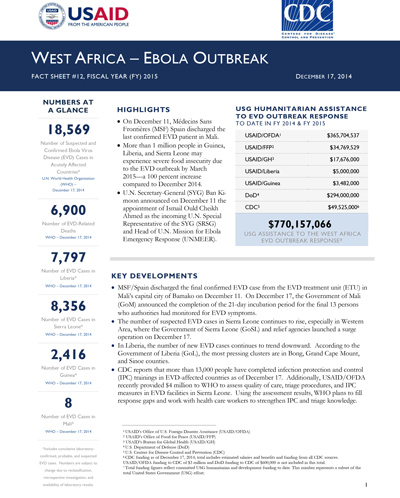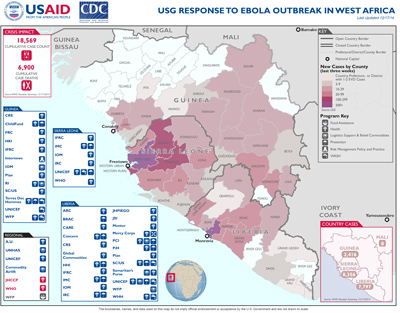December 31, 2014
HIGHLIGHTS
Ebola Response
Visit our main West Africa Ebola Outbreak page to learn more about how we're responding to the West Africa Ebola outbreak, and what you can do to help.
- In an effort to mitigate EVD transmission, the Government of Sierra Leone (GoSL) initiated a temporary lockdown in Sierra Leone’s Northern Province on December 25.
- A USAID/OFDA partner opened a new EVD treatment unit (ETU) in Liberia’s Sinje town, Grand Cape Mount County, on December 29.
- Regional EVD specimen testing capacity has increased with the opening of a USG-supported laboratory in Liberia and Belgian-run laboratory in Guinea, according to the U.N. Mission for Ebola Emergency Response (UNMEER).
West Africa Ebola Factsheet #14, December 31, 2014 ![]() (pdf - 293k)
(pdf - 293k)
KEY DEVELOPMENTS
- On December 25, the GoSL instated a five-day lockdown in Sierra Leone’s Northern Province—comprising Bombali, Kambia, Koinadugu, Port Loko, and Tonkolili districts—to bolster EVD containment efforts. The lockdown is limiting population movements, closing markets and shops, restricting public gatherings, and preventing all travel not related to the EVD response.
- On December 29, the ETU in Grand Cape Mount’s Sinje town, Liberia, opened with an initial 10 beds. Managed by USAID/OFDA partner the International Organization for Migration (IOM), the Sinje ETU will significantly aid relief actor efforts to address the county’s high EVD caseload.
- On December 24, USAID/OFDA partner Global Communities conducted the first ten burials at Liberia’s new national cemetery. Safe and dignified burials are a vital component of the EVD response in Liberia, according to health actors.
CURRENT SITUATION
West Africa Ebola Map #14, December 31, 2014 ![]() (pdf - 719k)
(pdf - 719k)
Liberia
EVD response actors continue efforts to monitor and mitigate ongoing EVD transmission in Liberia’s Montserrado and Grand Cape Mount counties. While Montserrado continues to report the highest number of cases in Liberia, CDC has identified hotspots in four of Grand Cape Mount’s five districts. From December 4–24, the Government of Liberia (GoL) reported 18 confirmed cases in the county, placing it second only to Montserrado in the number of confirmed cases per county during that time period. CDC continues to deploy field teams to Grand Cape Mount to support the county health team efforts—in particular, assessing the status of individuals in quarantine and delivering supplies.
Coordination among Bomi, Gbarpolu, and Grand Cape Mount counties is critical to mitigate the likelihood of persistent transmission in Grand Cape Mount contributing to the spread of EVD to neighboring counties. County health team representatives from the three counties report that current response challenges include community denial of response activities, inadequate EVD screening measures at inter-county transit points, and unsafe burial practices. In an effort to facilitate consistent dialogue, the representatives plan to attend a monthly tri-county coordination meeting to facilitate consistent dialogue.
To further strengthen response efforts in Grand Cape Mount, USAID/OFDA partner IOM hosted an Incident Management System session in Sinje on December 29 to improve EVD response coordination. The event highlighted response needs in Grand Cape Mount, such as improved coordination and increased resource investment by all response actors.
A DoD-supported construction team completed an ETU in Nimba County’s Ganta town and handed it over to USAID/OFDA partner Project Concern International (PCI) on December 27. PCI expects to open the facility in early January. Once open, the ETU will serve EVD patients from Nimba—located in northeastern Liberia and bordering both Guinea and Côte d’Ivoire. In addition to EVD treatment, PCI is also providing support to patients’ families and EVD survivors reintegrating into their communities through a team of eight psychosocial counselors.
After reporting zero new cases for more than two months, health actors in Nimba County recently reported two confirmed cases—a mother and child who crossed the border into Liberia from neighboring Guinea. In response, CDC deployed a field team on December 22 to investigate and meet with county health officials. Contact tracers have located at least 47 contacts of the two confirmed cases—including five health care workers—who are currently residing in a holding center. As of December 27, all contacts at the holding center had tested negative for EVD and none had shown symptoms.
On December 27, Disaster Assistance Response Team (DART) and DoD representatives participated in the official handover of Nimba County’s Tappita ETU—transferring the facility from the DoD partner that constructed the ETU to USAID/OFDA partners. Non-governmental organization (NGO) Heart to Heart International (HHI) will clinically manage the ETU with support from other USAID/OFDA partners.
On December 24, the DART and Commander of the U.S. Joint Forces Command Major General Gary Volesky toured the newly opened U.S. Army diagnostic laboratory in Sinoe County’s Greenville town. The laboratory will provide rapid diagnostic support for a forthcoming ETU in Greenville and other health sites in surrounding areas. With the operationalization of the laboratory in Greenville, DoD is staffing a total of six diagnostic laboratories across Liberia and assisting Liberia’s national laboratory housed at the Liberian Institute for Biomedical Research.
CDC continues to support the strengthening of IPC measures across Liberia. CDC is providing technical assistance to partners supporting IPC coverage in all 291 health care facilities identified in Montserrado and is working with the GoL Ministry of Health (MoH) to develop IPC guidelines to support the safe reopening of Liberian schools, which have been closed since July due to the EVD outbreak.
Sierra Leone
On December 25, the GoSL declared a five-day lockdown in Sierra Leone’s Northern Province, which comprises Bombali, Kambia, Koinadugu, Port Loko, and Tonkolili districts, according to local officials. Similar to restrictions imposed by the GoSL in Western Area to contain the EVD outbreak, the lockdown in Northern Province is limiting population movements, closing markets and shops, restricting public gatherings, and preventing all travel not related to EVD response activities. In Sierra Leone’s Western Area, relief organizations and U.N. agencies continue to expand surge activities and EVD response capacity by increasing the availability of beds, training surveillance officers and other response staff, and evaluating IPC conditions. Since the GoSL formally announced surge operations on December 17, relief organizations have expanded capacity by recruiting more than 2,000 additional health care workers and organizing 30 ambulances, as well as opening three ETUs in Western Area, according to the U.N. Children’s Fund (UNICEF). Relief partners report that existing facilities in Western Area continue to have sufficient EVD treatment capacity.
The USAID/OFDA-supported Lunsar ETU operated by the International Medical Corps (IMC) provides triage activities, trains health care workers, and admits suspected, probable, and confirmed EVD cases. The ETU has 53 operational beds—12 probable, 18 suspected, and 23 confirmed—with the capacity to scale up to 60 beds as needed. Since opening on December 1, the ETU has treated 43 confirmed EVD patients and discharged 10 EVD survivors. As of late December, ETU staff members were treating 11 confirmed EVD patients and 10 probable or suspected patients. IMC reported that the Western Area surge operations have not increased the number of patients seeking treatment at the facility, underscoring reports that facilities in Western Area continue to have sufficient treatment capacity.
In late December, USAID/OFDA provided an additional $10 million in FY 2015 funding to UNICEF to support EVD response efforts—including rapid response teams—in Sierra Leone.
Guinea
During the week of December 22, CDC’s IPC team in Guinea traveled to Coyah Prefecture to establish—in collaboration with WHO and the Government of Guinea (GoG) MoH—an isolation unit for suspected EVD cases at Coyah’s prefectural hospital. The IPC team is also working with NGOs Médecins Sans Frontières and JHPIEGO and the GoG MoH to establish a triage system at Conakry’s Donka Hospital.
Health actors recorded 183 EVD cases—including 164 confirmed, 1 probable, and 18 suspected—in Guinea between December 15 and 21, according to WHO. The caseload represents an increase of 88 confirmed, probable, and suspected cases over the previous week, with the majority of the new cases reported in Kindia, Kissidougou, and Macenta prefectures. CDC continues to prioritize epidemiological and surveillance support to these prefectures.
As of December 24, Belgian military technicians had begun operating a Government of Belgium-provided laboratory in the ETU in Guinea’s Nzérékoré Prefecture, UNMEER reports.
Mali
In late December, USAID/OFDA provided an additional $4 million in FY 2015 funding—including more than $2 million to IOM to support community surveillance and rapid response teams and $2 million to IMC to support rapid response teams—to bolster EVD response efforts in Mali.
LOGISTICS AND RELIEF COMMODITIES
In response to an increase in the number of EVD cases in Sierra Leone in recent weeks, the DART transferred 21,600 personal protective equipment coveralls from Liberia to Sierra Leone to address supply gaps.
On December 26, the Logistics Cluster in Guinea—the coordinating body for humanitarian logistics activities led by the U.N. World Food Program (WFP)—launched a domestic medical evacuation service via a helicopter equipped with an isolation apparatus. The service is available for Guinean and international health care personnel, as well as NGO and U.N. staff, with suspected or confirmed EVD.
The U.N. Humanitarian Air Service (UNHAS) recently expanded its domestic air service in Guinea by basing an UNMEER-provided helicopter in southeastern Guinea’s Kissidougou city, Kissidougou Prefecture. UNHAS is using the helicopter to transport passengers and light cargo from Kissidougou city, which hosts a WFP logistics hub, to key towns in Beyla, Guéckédou, Kérouané, and Macenta prefectures.
FOOD SECURITY AND LIVELIHOODS
In late November and early December, USAID/OFDA partner Catholic Relief Services (CRS) conducted a rapid seed system security assessment in Sierra Leone’s Bombali, Kailahun, and Koinadugu districts to measure harvest quality, production constraints, and seed availability, as well as to determine agriculture and food assistance needs. Based on the recent assessment, CRS reported harvests were largely favorable in the assessed areas, except in areas severely affected by EVD during critical land preparation and seed sowing periods. In the majority of areas assessed, farmers projected that sowing rates would likely increase in the next season. Farmers who reported expecting to sow less seed in the next season cited constraints related to illness, a lack of money, and theft as key challenges, as opposed to lack of available seed in their communities. CRS reported that most local markets within the assessed districts were functioning, supporting the availability of local food commodities and seed. However, CRS noted significant market constraints between districts and neighboring countries due to trade restrictions and quarantines.
PUBLIC DONATION INFORMATION
- The most effective way people can assist relief efforts is by making cash contributions to humanitarian organizations that are conducting relief operations. A list of humanitarian organizations that are accepting cash donations for disaster responses around the world can be found at www.interaction.org.
- USAID encourages cash donations because they allow aid professionals to procure the exact items needed (often in the affected region); reduce the burden on scarce resources (such as transportation routes, staff time, and warehouse space); can be transferred very quickly and without transportation costs; support the economy of the disaster-stricken region; and ensure culturally, dietary, and environmentally appropriate assistance.
More information can be found at:
- The Center for International Disaster Information: www.cidi.org or +1.202.821.1999.
- Information on relief activities of the humanitarian community can be found at www.reliefweb.int.
USAID/OFDA bulletins appear on the USAID website at what-we-









Comment
Make a general inquiry or suggest an improvement.